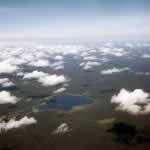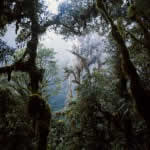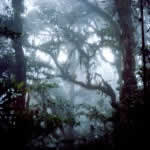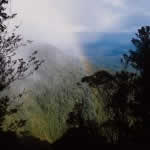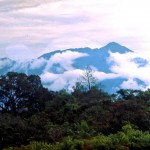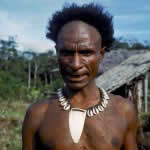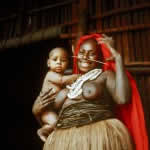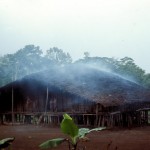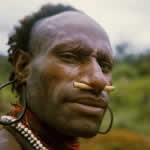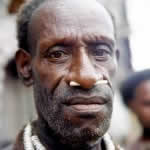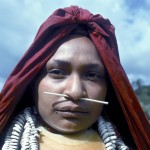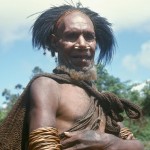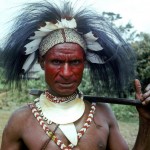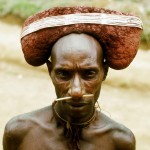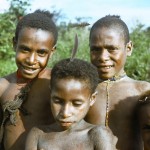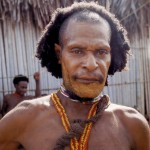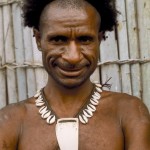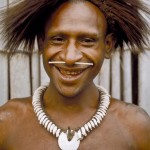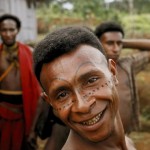Never ever in the evolution of human life on Earth there will be again communities like the Bosavi forest people at the time of our visit in 1966 – being totally independent of our civilization.
Never ever again there will exist any tribal cultures in their own right.
Our generation is experiencing the final and dramatic change from distinct ethnic diversity and traditional maintenance of endemic ways of life, towards a global conformity, inter-relationship and inter – dependence. This stage of human evolution never happened in any comparable way before nor can it be repeated. We witness an unique transition.
Our Bosavi portraits were photographed 40 years ago. Men, women and children are present here close up face to face; not as usual in anthropological literature or in adventure books: as rather stiff and strange, remote, exotic people – savages and cannibals. Here they are human beings above all. And they show us the insignia of their own civilization, with pride.
You may look into their eyes and get a sense of their endurance of living in tiny communities widely dispersed over the vast realm of the rainforest, the „Papuan Wonderland“ as is was described in Jack Hides‘ classic book of 1936. You may also sense their strength and passion: these are not just „primitive“ dwellers of the forest, but individual members of a highly sophisticated community sustaining in the shelter of their only one built home a delicate relationship with the surrounding natural world.
Look into their eyes and you may sense the wisdom which has accumulated in their society over countless generations and was forwarded by tradition – until all came to an abrupt end.
What you cannot retrieve from these portaits is the knowledge they possessed – and was abandoned largely since. It’s gone forever. Only fragments were documented by researchers like Edward and Bambi Schieffelin, and by ourselves. Stephen Feld recorded their Songs from the Forest – an intrinsic document.
Since these portraits were taken, the Bosavi people had to go through a nightmare of agonies, of impacts by the so called achievements of our modern ways of life. First arrived the missionary and the new religion invaded their minds step by step, alongside with certain ways of European thinking. Our regular school system replaced the role of the elders telling the younger generation. Money values replaces the old barter system: there is no ceiling for money wealth, as you know.
Then came epidemics: flu and other ( for these people) lethal diseases extinguished about 40 % of the sparse population, famine spread, because the Australian Administration forced people to stay put at one place and abandon their former semi-nomadic pattern of habitation in relation to the limited resources of the forest – sago above all. Then came the invasion of oil propectors and at last: the loggers trying to take the base of the Bosavi livelihood.
Who took notice of the agony these people faced day by day? Who possibly could have been acquainted as there is no publicity reaching the outside from their homeland. There exist two small charities „Friends of Bosavi“ and „Bosavi People’s Fund“: but what do they support? Mostly better schooling, again a pattern of the new way of life which the Bosavi had to take on– there is no option for any alternatives. Is that the achievement these charities persue? Besides some humanitarian aid and advice…
Yes, look again deep into these faces: in the old days there was no need for any such help. These people were self-content. Humanitarian aid ? Why and what for! It never had been an issue before our civilization reached Bosavi.
„We must help these poor people“ pronounce the loggers – and are ready to take away their wealth and subsistence. WWF takes care of the forest communities – so it states. But whoever went to check and find out the truth? And who monitors the spending of all the donations this and other conservation NGOs receive? Certainly two facts are evident: these funds did not reach the people in the villages to the extent we are misled to believe, and genuine conservation on the ground is limited to what these people have achieved since times immemorial.
In Papua New Guinea the magnificent rainforest is being taken away from the people partly by their own big brothers which want to get rich and richer – so what chance is granted to the Bosavi village communities to survive? Only by their strong self-defense: So far the land owners stood firm against any sneaking offers. Bosavi clan leaders even initiated their own organisation, the „Kosuo Orogo Resource Holders Association (KORA) „to promote greater awareness of the negative impacts of industrial logging and to encourage sustainable use of biodiversity“. But watch out KORA: This is one of those ever repeated phrases proclaimed by the big conservation NGOs, the so called BINGOS. Watch out that they are not becoming just another threat to your forest communities‘ livelihood; using smooth wordings for new shambles!
Now you may look into the eyes of the Bosavi forefathers with sorrow. Don’t be ashamed if you cry…
Yet, their sons and daughers do not really need nor desire your compassion. All they want is to hold on to what is their own for countless generations, and to share the world community’s rights as respected equal partners.
See also: Bosavi images – part 2
